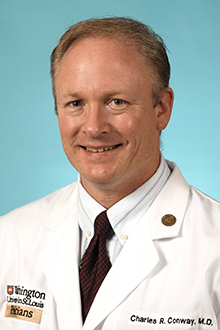When Is Depression ‘Treatment Resistant’?
Abstract
Lacking a consensus definition of TRD, some patients receive multiple trials of SSRIs when they might better respond to alternative treatments such as transcranial magnetic stimulation or electroconvulsive therapy.
When should you, the prescriber, conclude that your patient with depression is “treatment resistant,” and thereby eligible for alternative non-pharmacological interventions—such as vagus nerve stimulation (VNS), electroconvulsive therapy (ECT), or transcranial magnetic stimulation (TMS)?

Charles Conway, M.D., says the lives of patients with treatment-resistant depression (TRD) are improving, thanks to new treatment strategies. But he believes the field needs to agree on a definition of TRD.
There are multiple ways that the failure to agree on a standardized definition of treatment-resistant depression (TRD) impacts the clinical care of patients who do not respond to multiple medication trials. In an article appearing in the January 2017 issue of JAMA Psychiatry, Charles Conway, M.D., Mark George, M.D., and Harold Sackheim, Ph.D., wrote that the lack of a consensus definition around what constitutes TRD “limits the ability to do comparative treatment research, to understand the biological underpinnings of TRD, and produces ambiguous medical insurance coverage issues.”
Drawing on data from the Sequenced Treatment Alternatives to Relieve Depression (STAR*D) trial, they proposed a definition for TRD: failure to respond to two trials of an antidepressant prescribed at an adequate dose for an adequate duration of time.
Conway, a professor of psychiatry and director of the Treatment Resistant Depression and Neurostimulation Clinic at Washington University, St. Louis, said that in the absence of a consensus definition of TRD, patients often receive multiple trials of medication. “Our experience has been that when faced with patients who do not respond to a series of medications, clinicians typically continue to give more similar medications, despite there being no evidence to support that the 5th or 6th medication will work,” he told Psychiatric News.
In November 2015, Conway and colleagues reported in the Journal of Clinical Psychiatry on the clinical characteristics of 79 patients with TRD who were living in the community and referred to a university-based TRD specialty clinic. The researchers found that on average TRD patients had been exposed to more than three failed SSRI trials. “If fluoxetine didn’t work, sertraline was tried, then citalopram, then escitalopram, despite no evidence to support that serial SSRIs have any hope in improving treatment-resistant depression,” Conway told Psychiatric News.
ECT, as well as newer technologies such as VNS and repetitive transcranial magnetic stimulation (rTMS), have been approved by the FDA, but insurance coverage is inconsistent. “Often, psychiatrists or other treating physicians will have to go to great lengths to get insurance companies to pay for various treatments,” Conway said. “Patients end up not being able to receive ‘novel’ treatments that have been shown to be effective. If the field agreed upon the concept that failure to respond to two adequate dose-duration antidepressant treatments likely sets the patient apart—in need of novel treatments—I believe it’s possible that insurance coverage would likely be less resistant.”
APA Director of Research Philip Wang, M.D., Dr.P.H., agreed. “Without an agreed upon definition of TRD, different payors may be using different criteria to determine what they will reimburse for,” he said. “Ideally, you would have a uniform definition so that insurance coverage would be more consistent. In the same way, individual clinicians may be using different criteria to determine when to recommend an alternative therapy. Ideally you would want them using the same criteria.”
In STAR*D, patients with MDD received sequential treatment with antidepressants or psychotherapy using evidence-based antidepressant treatment strategies. At each stage of treatment, the likelihood that patients would respond decreased.
In the JAMA Psychiatry article, Conway and colleagues wrote that the “inflection point at which resistance markedly increased was level 3 (two adequate dose-duration treatments).” At that point, fewer than one in five patients remitted, they noted. “At subsequent trials (level 4) treatment failure rose to 90 percent,” Conway and colleagues wrote.
“After failure of two adequate dose duration trials of antidepressants, augmentation strategy, or psychotherapy, a precipitous decrease to a remission rate of five percent or less was observed,” they wrote. “We believe this represents a starting point for operationally defining TRD.”
Wang said the use of STAR*D data to derive an evidence-based definition of TRD is a prudent one. “On the face of it, in terms of the rigor of the data that went into their proposed model, the authors’ definition seems reasonable and well justified,” he said.
Conway said he believes there is much reason to hope for more effective treatment of TRD. “The development of multiple lines of research, including NMDA antagonists such as ketamine, anti-inflammatories, and improved and evolving neurostimulation techniques have markedly improved the lives of TRD patients,” he said. “Further, genetics, genomics, and neuroimaging offer tools to better understand and perhaps personalize treatment for TRD.” ■



